Finding the perfect substitute for Aleppo peppers can feel like a mini quest in your kitchen adventure.
You’ve probably been there – you’re jazzing up a dish, aiming for that punchy, distinct taste, and boom, you realize your spice stash is missing Aleppo peppers.
No sweat, we’ve got you covered with five rockstar alternatives that promise to keep your dishes singing with flavor. No need to hit pause on your cooking groove.
These swaps are not just about heat; they’re about adding depth and character to whatever you’re whipping up.
Ready to keep the culinary magic alive?
With these substitutes, your dishes will never know what hit them.
What are Aleppo Peppers?

Aleppo peppers are a type of chili pepper that originates from Syria, although they can now be found worldwide.
These peppers are dried out and crushed into flakes or powder as spices for cooking.
Aleppo pepper has a mild to moderate level of spiciness and is not as spicy as other peppers such as habaneros or sequins.
These peppers grow on can grow up to one and a half meters high and produce small yellow-green flowers and bright red fruit.
However, the pepper itself is long and narrow like a banana pepper and is generally four to eight centimeters in length.
These peppers can be used as a substitute for crushed red pepper or paprika and are becoming increasingly popular due to their smoky, sweet taste that makes them very versatile in cooking.
The 5 Best Substitutes for Aleppo Peppers
Aleppo peppers are a popular ingredient in Middle Eastern and Mediterranean cuisines, known for their mild heat and fruity flavor.
If you don’t have access to Aleppo peppers or prefer alternative options, there are several substitutes that can provide a similar taste profile.
In this guide, we will compare the top 5 substitutes for Aleppo peppers, discussing their key characteristics and suggesting proper ratios to ensure excellent results in your culinary creations.
| Substitute | Key Characteristics | Proper Ratio |
|---|---|---|
| Cayenne Pepper | Hotter with a similar fruity flavor to Aleppo peppers | Use half the amount of cayenne pepper compared to Aleppo peppers |
| Crushed Red Pepper Flakes | Hotter and less fruity than Aleppo peppers | Use half the amount of crushed red pepper flakes compared to Aleppo peppers |
| Ancho Chili Powder | Mild to medium heat with a sweet and smoky flavor | Use an equal amount of ancho chili powder as a substitute for Aleppo peppers |
| Pasilla Chili Powder | Mild to medium heat with a rich, earthy flavor | Use an equal amount of pasilla chili powder as a substitute for Aleppo peppers |
| Pimento de Padron (Spanish Peppers) | Mild to medium heat with a slightly sweet and smoky flavor | Use an equal amount of pimento de Padron as a substitute for Aleppo peppers |
Now let’s dive into each substitute in more detail:
1 – Cayenne Pepper
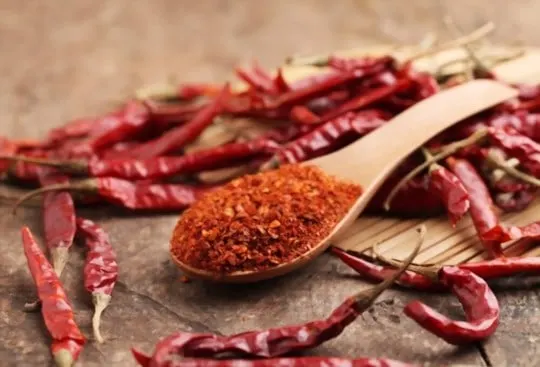
Cayenne pepper is a type of chili powder used in cuisines worldwide to add a bit of spice and a lot of taste.
This pepper originated from Cayenne, an area near French Guiana.
It’s crucial to note that cayenne peppers are usually red when fully mature but may be white, yellow, or red when they are still unripe.
This pepper is, on average, 30,000 to 50,000 Scoville units.
The level of spiciness in this chili is due to the presence of capsaicin.
It’s important to note that cayenne pepper isn’t typically very smoky, but it does have a lot of heat.
When using cayenne pepper as a substitute for Aleppo pepper, you may find that your dish turns out somewhat milder than anticipated.
- Key Characteristics: Cayenne pepper is hotter than Aleppo peppers but offers a similar fruity flavor. It provides a good substitute when you want to maintain the heat level while adding a little extra kick to your dishes.
- Proper Ratio: Use half the amount of cayenne pepper compared to Aleppo peppers. Adjust the quantity based on your taste preferences and recipe requirements.
2 – Crushed Red Pepper Flakes
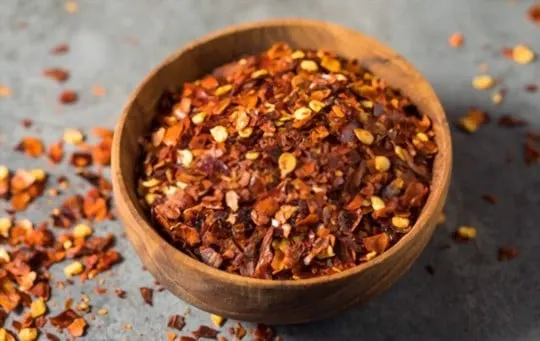
Another popular substitute for Aleppo pepper is crushed red pepper flakes.
These flakes are typically made from dried cayenne peppers and seeds.
In addition, these peppers may be ground into a powder before being sold as crushed red pepper or left whole with the stems still attached after being dried out.
Crushed red pepper flakes have a lot of heat that can range anywhere between 30,000 and 50,000 Scoville units.
It’s important to note, however, that different peppers may have different levels of heat even if they are of the same variety.
The main objective of using crushed red pepper flakes as a substitute for Aleppo peppers is to find something with enough heat so that your dish doesn’t turn out bland.
- Key Characteristics: Crushed red pepper flakes are hotter and less fruity compared to Aleppo peppers. They can be used as a substitute when you desire more heat in your dishes, while sacrificing some of the fruity notes.
- Proper Ratio: Use half the amount of crushed red pepper flakes compared to Aleppo peppers. Adjust the quantity based on your taste preferences and recipe requirements.
3 – Ancho Chili Powder
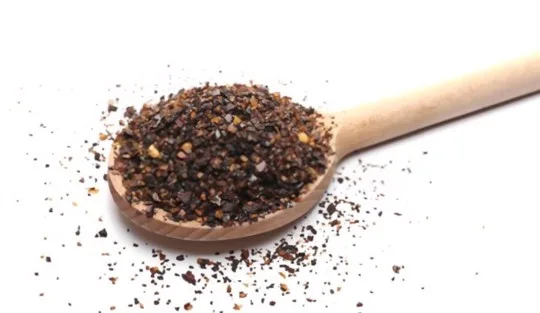
Ancho chili powder is made from anchos, which are dried poblanos.
When substituting Aleppo peppers with ancho chili powder, remember that the latter ingredient has a smoky richness even though it doesn’t have as much heat.
This may result in your dish has a more mild taste than anticipated.
Finally, ancho chili powder has a deep red color that any cook would love to have in their meal.
When using ancho chili powder as a substitute for Aleppo peppers, remember to add it later in the cooking process.
This is because this particular type of chili powder will burn if cooked too long or at too high of a temperature.
- Key Characteristics: Ancho chili powder offers a mild to medium heat level with a sweet and smoky flavor. It can provide a similar taste profile to Aleppo peppers, especially in recipes where the fruity notes are not prominent.
- Proper Ratio: Use an equal amount of ancho chili powder as a substitute for Aleppo peppers. Adjust the quantity based on your taste preferences and recipe requirements.
4 – Pasilla Chili Powder
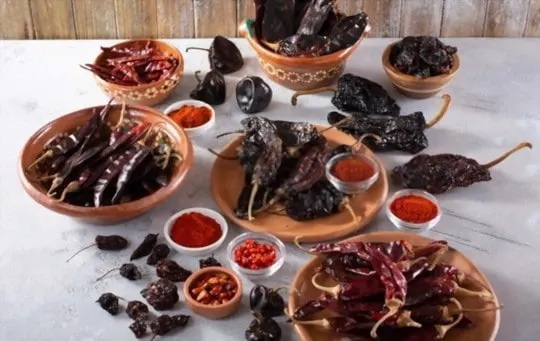
Last but not least, pasilla chili powder is another common substitute for Aleppo pepper.
This powder is made from dried pasilla chilies.
These are typically milder than other chili powders available on the market, similar to cayenne pepper.
Much like ancho chili powder, this type of chili powder has a rich taste but doesn’t have as much heat as crushed red pepper flakes or cayenne pepper.
In addition, this powder has a deep brown color.
To maximize the flavor of pasilla chili powder as a substitute for Aleppo peppers, it’s best to add it toward the end of cooking or sprinkle it on top of your dish after cooking is done.
- Key Characteristics: Pasilla chili powder has a mild to medium heat level with a rich, earthy flavor. It can add depth and complexity to dishes, making it a suitable substitute for Aleppo peppers in certain recipes.
- Proper Ratio: Use an equal amount of pasilla chili powder as a substitute for Aleppo peppers. Adjust the quantity based on your taste preferences and recipe requirements.
5 – Pimento de Padron (Spanish Peppers)
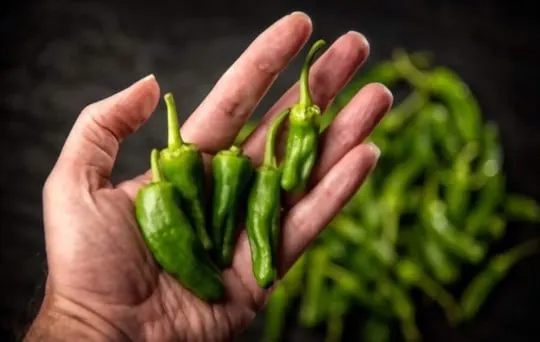
Last but not least, Pimento de Padron is a type of pepper that closely resembles Aleppo pepper.
These peppers typically measure between 1,000 and 5,000 Scoville units on the heat scale.
In addition, these peppers have a deep red color with thin skin.
The plant itself grows to about 2 feet tall and has small yellow flowers.
Pimento de Padron is an excellent substitute for Aleppo pepper due to its quick cooking time and rich flavor, even though it doesn’t have as much spiciness.
A common way of using these peppers is by sprinkling them with salt and eating them raw.
They can also be served fried in olive oil and seasoned with garlic and herbs.
While the plant itself is native to Spain, it has been grown in California since 1968 [and potentially much earlier].
- Key Characteristics: Pimento de Padron peppers offer a mild to medium heat level with a slightly sweet and smoky flavor. They can provide a similar taste profile to Aleppo peppers and are commonly used in Spanish cuisine.
- Proper Ratio: Use an equal amount of pimento de Padron peppers as a substitute for Aleppo peppers. Adjust the quantity based on your taste preferences and recipe requirements.
Conclusion
Aleppo pepper is a chili pepper with an earthy and tangy flavor with hints of citrus and smoke.
However, it’s important to note that this ingredient doesn’t have as much heat as other chili peppers, such as cayenne pepper or crushed red pepper flakes.
Many cooks substitute Aleppo peppers with one of the following alternatives: crushed red pepper flakes, ancho chili powder, pasilla chili powder, and pimento de Padron.
Each of these ingredients has a rich earthy flavor that can be beneficial to a dish and a smoky taste.
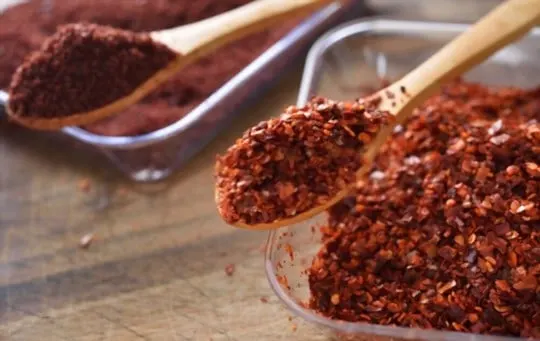
The 5 Best Substitutes for Aleppo Peppers
Ingredients
- Cayenne Pepper
- Crushed Red Pepper Flakes
- Ancho Chili Powder
- Pasilla Chili Powder
- Pimento de Padron Spanish Peppers
Instructions
- Pick your favorite substitute from the list above.
- Follow cooking directions for your selected substitute with the proper ratio of ingredients.

Andrew Gray is a seasoned food writer and blogger with a wealth of experience in the restaurant and catering industries. With a passion for all things delicious, Andrew has honed his culinary expertise through his work as a personal chef and caterer.
His love for food led him to venture into food writing, where he has contributed to various online publications, sharing his knowledge and insights on the culinary world. As the proud owner of AmericasRestaurant.com, Andrew covers a wide range of topics, including recipes, restaurant reviews, product recommendations, and culinary tips.
Through his website, he aims to inspire and educate fellow food enthusiasts, offering a comprehensive resource for all things food-related.

Leave a comment